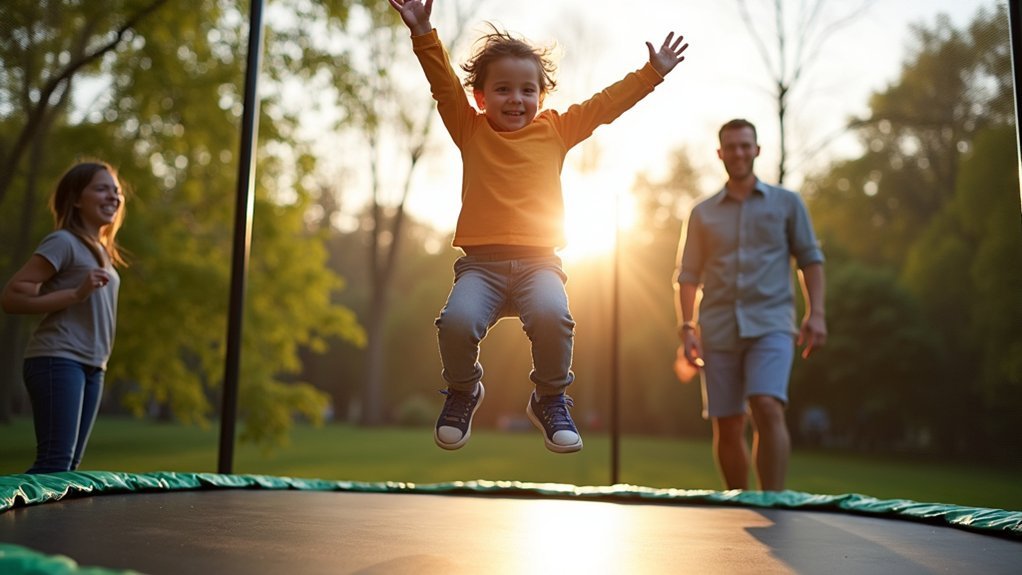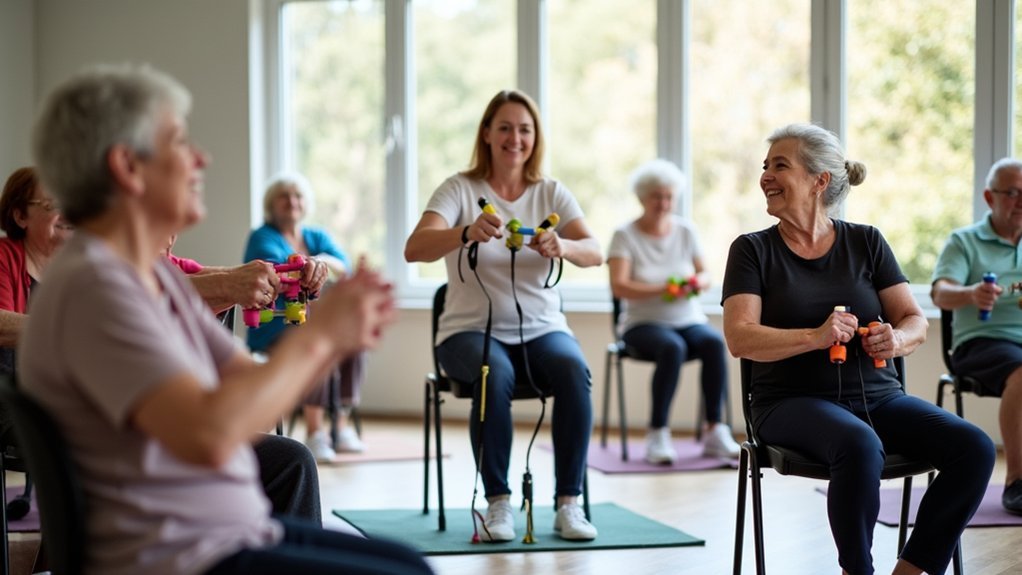Trampolines make exercise safer for kids through their shock-absorbing surfaces that reduce impact on growing joints. Unlike hard playground equipment, they provide controlled bouncing in an enclosed space, preventing falls and injuries. You’ll get low-impact cardio benefits while improving balance and coordination. With proper supervision and age-appropriate activities, trampolines offer a safer alternative to high-impact sports. Discover how this bouncy fitness option can transform your child’s exercise routine.
Impact Absorption: How Trampoline Surfaces Protect Growing Joints

While children’s boundless energy makes trampolines appealing, their design offers more than just fun—it actively protects developing bodies. The specialized shock-absorbing materials in trampoline surfaces markedly reduce impact forces that could otherwise stress your child’s growing joints.
Unlike hard surfaces that transfer force directly to joints, trampolines disperse weight evenly while absorbing shock. This clever engineering minimizes potential trampoline injuries by decreasing the stress placed on developing knees, ankles, and hips during activity.
You’ll find that most quality trampolines feature surfaces specifically designed to enhance vertical bounce while protecting joints. This impact absorption is essential for children’s developing musculoskeletal systems.
The cushioned surface creates a safer exercise environment where kids can build strength and coordination without excessive joint strain.
Controlled Bouncing: Minimizing Falls Compared to Playground Equipment
Parents often wonder about the safest exercise options for their active children, and trampolines offer surprising advantages in fall prevention compared to traditional playground equipment.
When your child engages in controlled bouncing on a trampoline, they’re actually participating in a more predictable form of exercise than climbing playground structures with varying heights.
Modern trampolines with proper enclosures considerably reduce trampoline-related injuries by keeping bouncing at a consistent height, unlike playground equipment where falls from climbing areas can result in more severe injuries.
Safety isn’t just about preventing falls—it’s about controlling their impact. Modern enclosed trampolines provide this crucial protection that playground equipment simply cannot match.
You’ll find that trampolines’ shock-absorbing surfaces cushion impacts, while playground falls often meet hard, unforgiving surfaces.
In supervised settings where bouncing rules are enforced, trampolines can provide safer, low-impact exercise that’s gentler on growing bodies than the unpredictable nature of playground play.
Enclosed Safety Nets: Creating Boundaries for Worry-Free Movement

When safety stands as your top priority for backyard fun, enclosed safety nets transform ordinary trampolines into worry-free exercise zones for your children.
These protective barriers notably reduce injuries by preventing falls from the jumping surface—a leading cause of trampoline-related accidents.
The American Academy of Pediatrics endorses these enclosures as essential safety features, not optional add-ons.
You’ll appreciate how the nets create clear visual boundaries that help your kids understand their jumping limits while allowing them unrestricted movement within the safe zone.
Remember to inspect your enclosed safety nets regularly for tears or damage.
Even small compromises in the netting can undermine their protective benefits.
With proper maintenance, these protective enclosures provide peace of mind while your children enjoy the exercise benefits of bouncing.
Low-Impact Cardio Benefits for Developing Bodies
Unlike high-impact activities that stress growing joints, trampolines provide an ideal cardiovascular workout for your child’s developing body. The bouncing motion elevates heart rate while cushioning the impact that typically strains knees, ankles, and hips during activities like running or basketball.
Your child gets remarkable efficiency with trampoline exercise—just 10 minutes of jumping equals a 30-minute run in calorie-burning potential. This low-impact cardio strengthens muscles and improves coordination without the injury risks associated with more strenuous activities.
The gentle, repetitive bouncing motion encourages children to exercise longer and more consistently, creating positive associations with physical activity. It’s fun for the whole family and sets the foundation for lifelong fitness habits while protecting growing bodies from unnecessary stress.
Proper Jumping Techniques to Prevent Common Injuries

Before letting your kids bounce away, make certain they warm up with light stretches to prepare their muscles for jumping.
Teach them to maintain proper form by landing with feet shoulder-width apart and staying centered on the trampoline surface.
Enforce a strict one-jumper-at-a-time rule to prevent collisions, which are among the most common causes of trampoline injuries in children.
Start With Warm-Ups
Since safety should be your top priority for trampoline activities, proper warm-ups are essential before your kids hop onto the bouncy surface.
Dedicating 5-10 minutes to simple stretching exercises helps prepare their muscles and joints for the dynamic movements they’ll experience while jumping.
Focus on warm-ups that target the legs, ankles, and core – areas most vulnerable during trampoline use.
Light jogging in place, gentle stretches, and ankle rotations can greatly reduce the risk of injuries sustained from sudden, unprepared movements.
These preventative measures are particularly important for children whose bodies are still developing.
Maintain Proper Form
While the excitement of bouncing can make kids enthusiastic to jump as high as possible, teaching proper form is essential for preventing injuries on trampolines.
Encourage your child to maintain a straight body position when jumping on a trampoline. This prevents awkward landings that often lead to sprains or fractures. Instruct them to keep arms at their sides or elbows bent to improve coordination and balance, reducing fall risks.
Always remind jumpers to land on both feet simultaneously rather than one, enhancing stability and preventing ankle injuries. Soft, controlled landings minimize impact forces on the body.
Most importantly, prohibit flips and somersaults, which dramatically increase the risk of head and neck injuries.
With proper technique, your child will build strength safely while enjoying this exciting exercise.
One Jumper Rule
Although trampolines offer tremendous fun, implementing the One Jumper Rule is perhaps the most essential safety measure you can enforce.
Research consistently shows that most serious trampoline injuries occurred when multiple children jumped simultaneously, resulting in dangerous mid-air collisions.
When you allow only one jumper at a time, you’re drastically reducing the risk of fractures and concussions that commonly happen during chaotic multi-person jumping sessions.
Pediatric safety guidelines strongly endorse this approach for good reason – it works.
As a parent or guardian, your supervision makes all the difference.
By firmly maintaining the One Jumper Rule, you’re creating a controlled environment where children can enjoy all the exercise benefits of trampolines while minimizing preventable accidents.
Don’t compromise on this rule, even when children beg to jump together.
Single-Jumper Rules: Preventing Collision Hazards During Exercise
Because multiple jumpers greatly increase injury risks, enforcing a one-person-at-a-time rule stands as the most important safety measure for trampoline use.
Implementing single-jumper rules markedly reduces the likelihood of dangerous collisions that commonly cause fractures and concussions.
One jumper at a time prevents the dangerous collisions responsible for most serious trampoline injuries.
When you establish strict one-at-a-time policies, you’re preventing collision hazards that account for most trampoline-related injuries:
- Children under 6 face particularly high risks when jumping with others
- The American Academy of Pediatrics strongly endorses single-jumper protocols
- Studies show this simple rule can greatly decrease serious injury rates
- Regular reminders about this rule help children develop safer jumping habits
You’ll create a markedly safer exercise environment by consistently enforcing this rule, allowing children to enjoy the fitness benefits without unnecessary risks.
Age-Appropriate Trampoline Workouts for Different Developmental Stages
Age-appropriate trampoline workouts guarantee your child develops safely while having fun.
For toddlers between 2-5 years old, you’ll want to focus on simple bouncing activities that build coordination without attempting risky maneuvers.
As your children grow into teens, you can introduce more challenging circuit progressions that incorporate strength training and light acrobatics while maintaining proper safety protocols.
Toddler-Specific Bounce Guidelines
While many parents look to trampolines for energy-burning activities, toddlers under age 6 face significant safety risks that require special consideration.
When implementing toddler-specific bounce guidelines, you’ll need to prioritize safety above all else.
- Limit supervised bouncing sessions to short durations, focusing on gentle hops rather than high jumps or tricks.
- Allow only one toddler at a time on the trampoline to prevent dangerous collisions.
- Incorporate simple movements like bouncing in place to develop balance and coordination.
- Inspect equipment regularly, checking for worn pads and ensuring enclosure nets are secure.
Teen Trampoline Circuit Progressions
Teenagers require more challenging physical activities than younger children, making trampolines an ideal platform for developing structured fitness routines. You can design age-appropriate circuits that enhance your teen’s agility, balance, and coordination as they continue developing these essential skills.
Create progressive workouts incorporating jumping jacks, tuck jumps, and bounce squats when they jump on a trampoline. These exercises improve cardiovascular fitness and build muscle strength in an engaging way that combats sedentary behaviors.
Always supervise trampoline sessions and enforce safety rules like allowing only one jumper at a time. Tailor circuit intensity to match your teen’s fitness level and physical capabilities, gradually increasing difficulty as they advance.
Regular trampoline workouts provide teenagers with active entertainment while contributing to their overall health during these pivotal developmental years.
Weather Considerations for Year-Round Trampoline Fitness
Trampolines don’t need to hibernate when seasons change, though you’ll need to adapt your approach throughout the year.
Weather considerations play a vital role in maintaining a safe outdoor environment for your children’s trampoline activities.
Before letting kids bounce in any season, guarantee:
- Clear snow and ice completely during winter months to prevent dangerous slips
- Schedule jumping sessions during cooler morning or evening hours in summer, with water breaks to prevent overheating
- Inspect the trampoline after storms or heavy rainfall, allowing surfaces to dry completely
- Install proper enclosure nets and padding that can withstand various weather conditions
Regular maintenance becomes even more important after extreme weather events.
Supervision Strategies for Safe Trampoline Exercise Sessions
To guarantee your child’s safety during trampoline exercise, you’ll need to implement proper adult spotting techniques by positioning yourself near high-risk areas and maintaining constant visual contact.
Schedule regular timed jumping breaks every 10-15 minutes to prevent fatigue-related accidents and give clear instructions to jumpers about proper landing positions.
Establish and consistently enforce clear safety rules, including the one-jumper-at-a-time policy and a strict no-somersaults rule, especially when hosting playdates with children of varying sizes and experience levels.
Adult Spotting Techniques
When children bounce on trampolines, proper adult supervision becomes the most essential safety factor in preventing injuries.
As a responsible supervisor, you’ll need to master effective spotting techniques that keep kids safe while they enjoy this excellent form of exercise.
Position yourself strategically around the trampoline and remember to:
- Enforce the one-jumper-at-a-time rule to prevent dangerous collisions
- Stand close enough to intervene quickly if a child attempts risky maneuvers like somersaults
- Regularly inspect the trampoline for wear and tear before each session
- Communicate safety rules clearly and consistently throughout jumping time
Your active involvement as a spotter is particularly critical for children under six, who need closer monitoring.
Timed Jumping Breaks
Beyond spotting techniques, implementing structured timed jumping breaks creates a safer, more controlled trampoline environment.
These intervals prevent fatigue and overexertion that often lead to accidents when children jump for extended periods.
During timed jumping breaks, you’ll have perfect opportunities for adult supervision to reinforce safety rules—reminding kids to take turns and avoid dangerous maneuvers like flips.
Use these pauses to quickly inspect the trampoline for wear or damage before resuming activity.
Clear Safety Rules
Establishing clear, non-negotiable safety rules forms the foundation of any successful trampoline exercise program for children.
When you use a trampoline with kids, consistent enforcement of these guidelines dramatically reduces injury risks while still allowing for active fun.
Always implement these clear safety rules:
- Maintain constant adult supervision during every jumping session
- Allow only one child to jump at a time to prevent dangerous collisions
- Ban somersaults and flips completely to protect against neck injuries
- Perform regular equipment checks for tears, exposed springs, or damaged nets
Post these rules visibly near your trampoline and review them before each session.
Balance and Coordination Development Through Structured Trampoline Play
The repetitive bouncing motion on a trampoline offers children more than just entertainment—it’s a powerful developmental tool for balance and coordination. As your child jumps, they’re engaging both sides of their brain simultaneously, creating neural pathways that improve overall body control.
| Benefit | How It Develops |
|---|---|
| Spatial Awareness | Children learn body positioning relative to their environment |
| Motor Skills | Repetitive movements build muscle memory for physical activities |
| Physical Confidence | Improved balance transfers to sports and daily activities |
You’ll notice your child making constant adjustments to maintain stability while bouncing, strengthening their equilibrium. These skills benefit the whole family, as structured trampoline sessions can become engaging activities everyone enjoys while developing essential physical abilities that last a lifetime.
Frequently Asked Questions
Why Is Jumping on a Trampoline Good for Children?
Jumping on a trampoline boosts your child’s cardiovascular health, strengthens muscles, improves coordination, stimulates their immune system, releases mood-enhancing endorphins, and reduces screen time by encouraging fun outdoor physical activity.
Are Trampolines Good for Child Development?
Yes, trampolines support your child’s development by building strength, improving balance, enhancing coordination, boosting cardiovascular health, stimulating cognitive focus, and developing confidence as they master new skills through enjoyable physical activity.
What Do Pediatricians Say About Trampolines?
Pediatricians strongly discourage home trampoline use, especially for children under 6. If you choose to have one, you’ll need adult supervision, single jumpers only, and regular equipment inspections to minimize injury risks.
Why Is Trampolining Good for Autism?
Trampolining benefits your child with autism by providing calming sensory input, improving motor coordination, and creating opportunities for social interaction. You’ll notice it helps regulate emotions while they’re having fun getting exercise.
In Summary
You’ve now seen how trampolines offer a safer exercise alternative for your children. With proper supervision, age-appropriate activities, and safety features like nets, you’ll support their physical development while protecting growing bodies. Remember to teach correct techniques and monitor weather conditions for ideal safety. By incorporating structured trampoline play into your children’s routine, you’re helping them build strength, balance, and coordination in a controlled, low-impact environment.





Leave a Reply